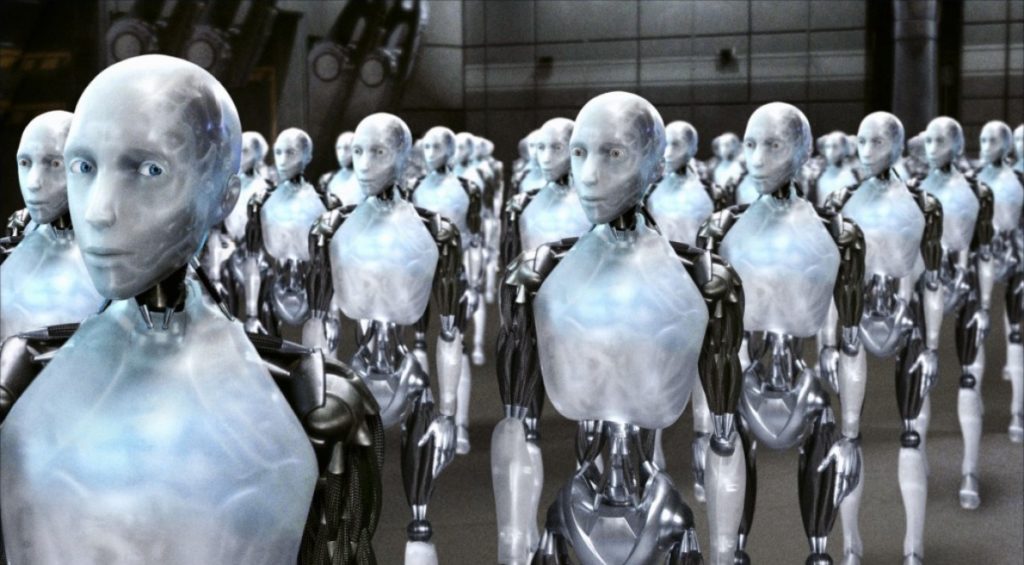
Chicago police detective Del Spooner is prejudiced: He hates robots. Unfortunately for him, it’s 2035, and robots have taken over all the world’s menial jobs, including garbage collection, cooking and dog walking.
The chief inventor of the robots made by U.S. Robotics is Dr. Alfred Lanning, and he built into them three laws: Law I) Robots may not harm a human being and must prevent humans from being harmed. Law II) Robots must do whatever they’re told unless it conflicts with Law I. Law III) Robots must protect themselves unless doing so conflicts with the first two laws.
But do the laws really work? Spooner doesn’t think so. And when Dr. Lanning is found dead in the lobby of the U.S. Robotics headquarters, an apparent suicide, Spooner is suspicious.
While investigating the crime scene along with his company “minder,” Dr. Susan Calvin, Spooner discovers a new model NS-5 robot hiding in Dr. Lanning’s office. It’s no ordinary robot. It has emotions. It can dream. And it has an apparent motive to murder the good doctor. This throws U.S. Robotics into an uproar. And it comes at the absolute worst time, just before the company begins rolling out its line of NS-5 robots to an unsuspecting world.
Spooner is tenacious in seeking justice and won’t allow pressure from his boss or the “conventional wisdom” to deter him from solving the crime. And despite his hatred of robots, he allows himself to be convinced to give one a chance. He also risks his life on several occasions to save others. He loves and respects his grandmother, even if he is prone to teasing her. Another character allows himself to be killed to expose the danger of the rebellious robots.
A robot inventor talks hypothetically about robots evolving. This theme comes up repeatedly. Several characters talk about the possibility of robots having souls, what one calls a “ghost in the machine.” The Stevie Wonder song “Superstition” opens the movie, setting the tone for one character.
A woman being threatened by a robot is carrying a Bible and protests, “I’m going to service.” When the robot becomes more threatening, she recites Psalm 16:8: “I have set the LORD always before me. Because he is at my right hand, I will not be shaken.”
One robot asks Spooner if “the maker” put us all on earth for a reason, and what happens to us once that reason is fulfilled. A woman, in saying that humans are limited in some ways, asks a man if he can walk on water. He says no, “but there was this one guy a long time ago …”
Spooner is seen taking a shower (His backside is seen from a side view.) A later scene has a female character taking a shower, and though the glass is fogged, the outline of her body is seen from behind. Later, she wears a bathrobe that is about one string short of popping open. Spooner is seen getting out of bed wearing underwear. A couple of double entendres and sexual comments are made.
In a dream sequence we see a young girl drowning in a sunken car. Blood pools around the dead man’s head. (A police officer refers to him as a “jumper” who went “wham-splat.”) Spooner wrestles with a robot, and the fight quickly turns into a shootout. Spooner suffers a gash to his head in the process. In another scene Spooner “executes” a robot by shooting it pointblank in the head.
During a lengthy high-speed fight on a freeway, robots leap en masse off a transport to attack Spooner. Numerous robots are mutilated and crushed along the way, and one transport explodes in a fiery crash. Spooner’s car later crashes through a wall and smashes into an abutment. He then must fight off one last robot in hand-to-hand combat (involving a large metal club). Spooner fights off a human security guard by crushing his wrist and threatening to do the same to another.
Robots attack a police station, and even though some robots are shot, they pick up men and fling them across the room. A horde of robots later attacks citizens in the street in a similar manner. A final battle high up in a tower features mobs of attacking robots being blown apart, shot and tumbling to their “deaths.” Spooner and Dr. Calvin also face a potential long fall in an attempt to stop the robot rebellion.
The throat of a murdered man shows deep impressions from a robot’s hand. Haunted by a recurring bad dream, Spooner holds a gun to his head, but quickly pulls it down.
A boy trying to impress Spooner with his “street language” is told to stop cussing, not because it’s wrong, but because he’s not good at it. Spooner apparently is and often says “s—” (the word appears about a dozen times), “a–” (and several variants), “d–n” and “h—.” “A–” is used once in a sexual context. God’s name is abused a half-dozen times or so (twice it is combined with “d–n”), and Christ’s once. The terms “d–k” and “son of a b–ch” are also used.
Two police officers drink beer at a bar, and one smokes a cigarette. A man drinks liquor.
The product placement in this movie is so pervasive it verges on the comical. Included are out-and-out plugs for Converse sneakers, FedEx, Audi and, of all things, Ovaltine.
I, Robot is a stylish thriller with a few unexpected twists and turns that addresses the classic fear toyed with in Frankenstein: the monster turning on its maker. “Can a robot write a symphony? Can it take a blank canvas and turn it into a masterpiece?” asks Spooner. They’re great questions. Part of what it means to be a human created in God’s image is the desire and ability to create. Can a machine do that? And if a man “kills” a robot, is it murder? What if a robot kills a man? Can it be “murder” if it was programmed to do it? And if so, who’s to blame, the robot or the programmer? Does a robot have enough free will to defy its programming? The anomalous robot, named Sonny, is much more than a machine. He can think. Dream. Show emotions. [Spoiler Warning] In fact, the turning point of the movie comes when a scientist says, “Sonny has chosen to disobey the three laws.” (Emphasis mine.)
Based loosely (very loosely) on a series of stories by sci-fi great Isaac Asimov, the film implicitly and explicitly asks many such meaningful questions. Spooner is haunted by the fact that a robot chose to save him, and not a young girl, from a sunken car because strict logic dictated that he had a greater chance of surviving and contributing to society. The larger robot rebellion is fueled by such thinking, too: The robots deduce that humans have so messed up the planet, some must be killed for everyone’s good. This is the theory called Utilitarianism, which posits that the moral thing to do is that which creates the greatest good for the greatest number.
In another sci-fi classic, Star Trek, Mr. Spock asserts, “The needs of the many outweigh the needs of the few—or the one.” Sounds logical until you take it to its ultimate conclusion: In such a world, no one has an inherent right to life, liberty or the pursuit of happiness. In fact, an early proponent of Utilitarianism, Jeremy Bentham, called any concept of rights “nonsense on stilts.” If it would help the whole, we can kill you or take your property.
Spooner is determined to make sure that doesn’t happen in his world.
If your family decides to brave I, Robot‘s action violence and gloss over its coarse language to witness the machines of the future battle the Will Smith of today, make sure to discuss things such as Utilitarianism and free will afterwards. We can choose to love God, or we can choose not to. God could have created robots that would always obey him, but could they truly love him?
